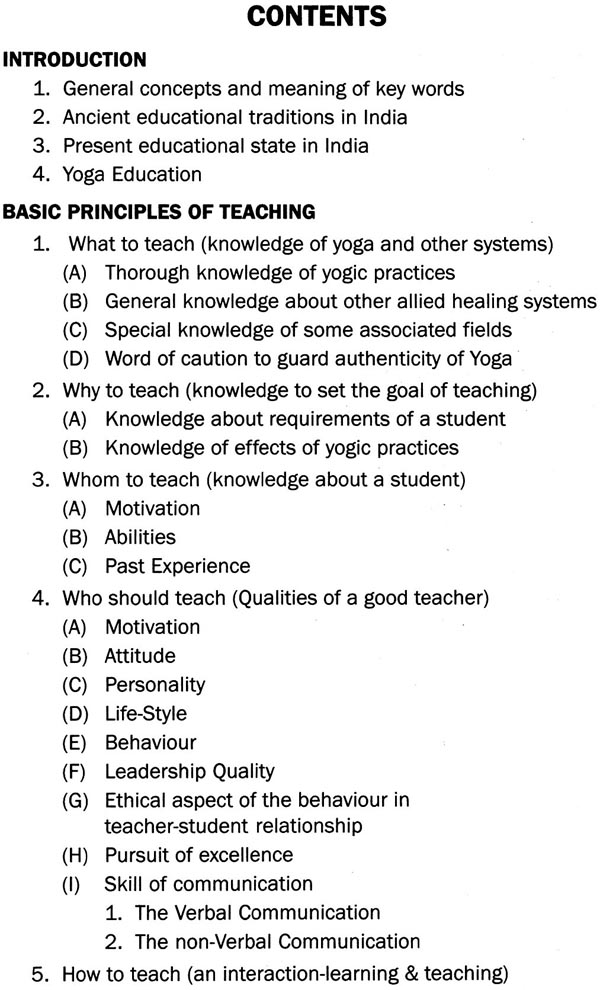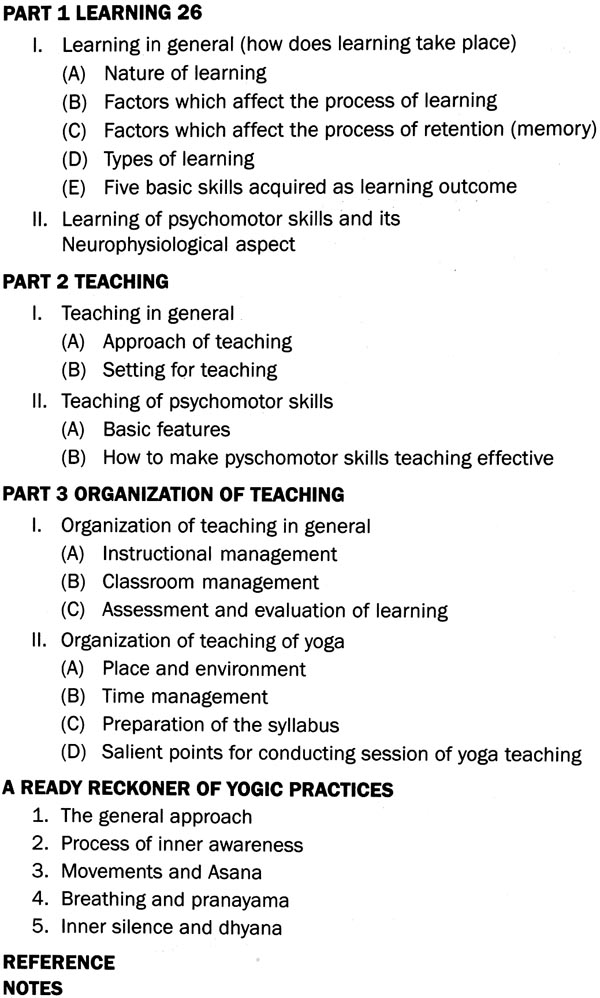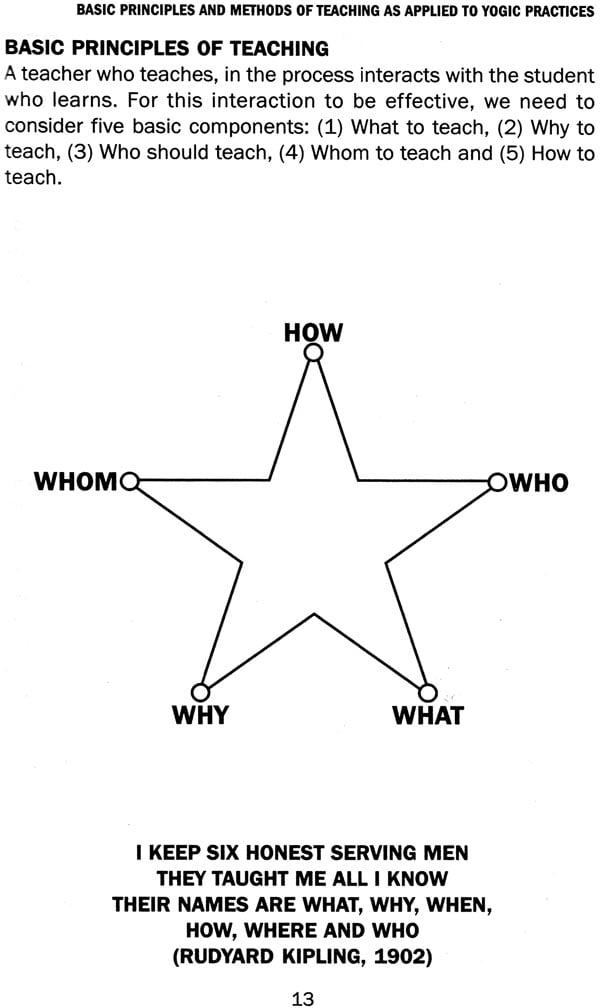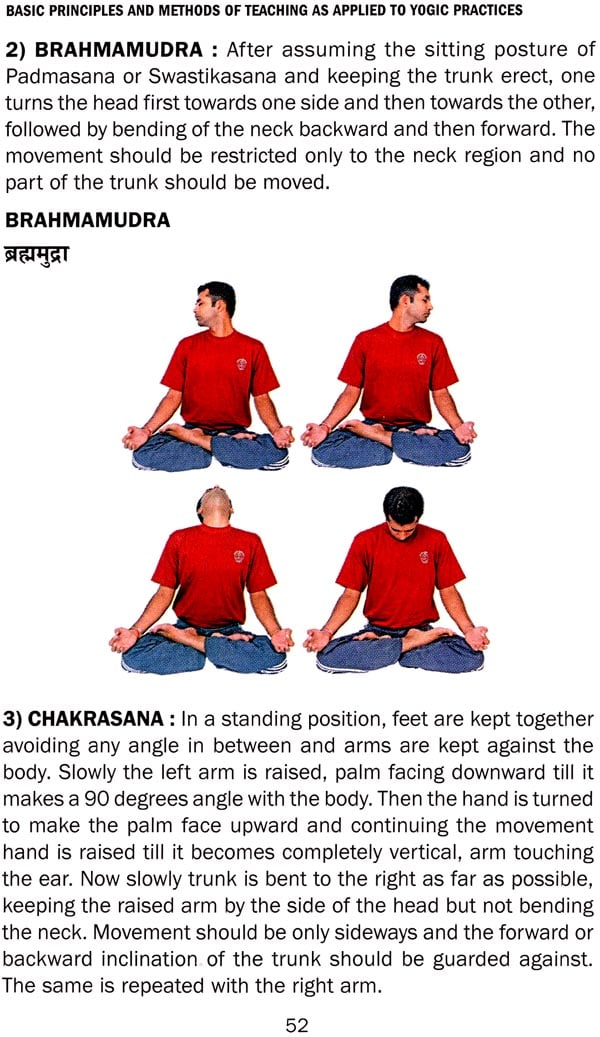
Notes On Basic Principles and Methods of Teaching As Applied To Yogic Practices and A Ready Reckoner of Yogic Practices
Book Specification
| Item Code: | NAR573 |
| Author: | Dr. Shrikrishna |
| Publisher: | Kaivalyadhama Samiti Lonavla |
| Language: | English |
| Edition: | 2018 |
| Pages: | 76 (19 Color Illustrations) |
| Cover: | PAPERBACK |
| Other Details | 8.50 X 5.50 inch |
| Weight | 120 gm |
Book Description
These notes try to present some of the basic concepts and methods from modern educational technology and suggest same easy and simple technology and suggest some easy and simple ways to use it with great advantage to make teaching of Yoga more effective. It also includes and easy to follow ‘Ready Reckoner’ of Yogic Practices which are commonly used.
Although these notes cover a wide area, the presentation is essentially brief and upto the point. These notes are only in the form of an adjuvant and cannot replace the lectures and the discussions during which further clarification and interrelationship between various concepts could be presented.
These notes on the topic of 'Basic Principles and Methods of Teaching as Applied to Yogic Practices' have been prepared to provide some background material for students of Diploma/ Certificate course in Yoga Education, being conducted by Kaivalyadhama, Mumbai.
These notes try to present some of the basic concepts and methods from modern educational technology and suggest some easy and simple ways to use it with great advantage to make teaching of Yoga more effective. It also includes an easy to follow 'Ready Reckoner' of Yogic Practices which are commonly used.
Although these notes cover a wide area, the presentation is essentially brief and upto the point. These notes are only in the form of an adjuvant and cannot replace the lectures and the discussions during which further clarification and interrelation-ship between various concepts could be presented.
1. General Concepts And Meaning of Key Words:
Teaching : to impart information or skill to a person to try deliberately to promote certain learning
Learning : to gain knowledge of, or skill in a subject by study or experience or by being taught
to become aware by information or from observation
to acquire, retain and apply the knowledge
Education : A process of systematic instruction and training designed to impart knowledge and develop skill
A process of learning is a continuous one. It may be a deliberate attempt or it may take place without the student being aware of it. It may take place in the formal setting of school, college etc. or in an informal setting through the interaction with the surrounding.
Teaching on the other hand is a deliberate attempt on the part of the teacher to impart some specific information or skill. The process of teaching could be made more effective if it is planned and organized with the knowledge of some basic principles of educational technology. When this knowledge is combined with the actual experience of teaching, it helps in making the teacher more useful for the student.
2. Ancient Educational Traditions In India :
(a) Family Tradition - It essentially involves the transfer of skills from father to son. In the earlier stages of human civilization it involved the teaching of skills essential for livelihood viz. hunting, fighting with the enemy etc., while in the later stages it included agriculture, trade, traditional crafts etc. The contents of teaching remained unchanged from generation to generation and any alteration or innovation was but rarely welcome. Emphasis was on continuity, conformity and on earning of livelihood.
(b) Gurukul Tradition - In this tradition student, could be a son of a Guru or could come from any other family, who would spend a significant period of his formative childhood along with other disciples in the Guru's Ashram. It was possible for the parents to select specific Gurukul for their off springs, where a particular desired skill was taught. There were stringent criteria for the selection of the student by each Guru. The student had to follow a certain discipline and therefore, was called disciple or Shishya. This tradition is, therefore, known as Guru-Shishya tradition. In this tradition there was a complete freedom for the Guru to adopt specific approach, readiness, aptitude and the ability of the student. The teaching methods adopted were invariably individualistic based on the experience, observations and traditions of the Guru. The emphasis was on the memorisation, and learning from the personal conduct of the Guru. This tradition evolved and revolved with the Guru as the centre.
(c) University Education - In ancient India, out of this Gurukul tradition arose very many large centres of learning wherein hundreds of teachers specialised in specific branches of knowledge would impart knowledge to thousands of students staying in the campus. The great universities of Taxilla (Takshashila) in Punjab, Nalanda in Bihar and Ujjain in Madhya Pradesh were some of the famous Universities attracting students from all over the ancient world.
3. Present Education State In India :
(a) In the last millennium and half, due to very unsettled political conditions in India many of these ancient Universities which had existed for many centuries, perished, the Gurukul tradition somehow survived in the form of small Pathashalas run by individual teachers in the most trying circumstances.
(b) With the advent of printing technology from the 15th century onward, in the western world teaching became more formalised, more institutionalized and more universal in its reach. With the arrival of Europeans in India, the whole field of education got influenced by these changes. New educational centers in the form of schools, colleges and universities came into existence. With the rapid increase in the branches and the contents of the knowledge about the world, the activity of teaching became more professional, more scientific and specific to the need of the subject to be taught and appropriate to the requirements of the student who would learn it. Thus, the 'Art of Teaching' came to lean heavily on the 'Science of Teaching.'
(c) With rapid advances in the 'Technology of Mass Communication' over the last 50 years, the teaching technology also changed drastically. The emphasis shifted from the teacher to the student and from teaching to learning. Now there is an unrestricted access to the source of knowledge without any need of specific preparation on the part of student. Teaching can become sometime impersonal with the teacher:student ratio shifting from 1:1 to 1:00. The student now can learn whatever he wants, as much as he wants and at a pace convenient and suitable to his learning ability. This flexitime approach is very much helpful for the serious student as he can learn creatively. But for the non-serious student this easy accessibility and non-requirement of any prior preparation can make the whole affair of acquiring knowledge as casual as shopping in a supermarket.
**Contents and Sample Pages**











